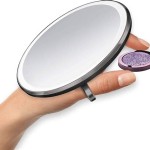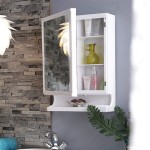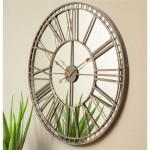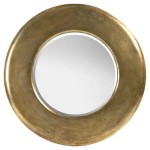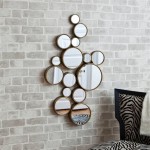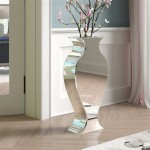Mirror to Hide TV: A Seamless Blend of Technology and Décor
The modern home often presents a design challenge: integrating technology, specifically television screens, without compromising the aesthetic integrity of living spaces. Traditional televisions, with their black screens and often bulky frames, can disrupt carefully curated décor. A potential solution lies in the application of a mirror to hide a TV, creating a dual-purpose element that seamlessly blends entertainment with sophisticated design.
Mirror TVs operate on a principle combining optical science and advanced materials. A specialized mirror, often referred to as a two-way mirror or a magic mirror, is constructed with a semi-transparent coating. This coating has the unique property of reflecting a significant portion of light when illuminated from one side (the viewer's side) while allowing light to pass through from the opposite side (the TV screen's side) when the television is powered on. When the television is off, the mirror effectively functions as a standard reflective surface, concealing the display entirely.
The application of mirror technology to conceal televisions has grown in popularity, driven by both aesthetic considerations and practical space-saving desires. These devices present a clean, uncluttered look, removing the visual dominance of the television screen within a room. They are especially appealing in minimalist designs, contemporary spaces, and locations where design is paramount, such as luxury hotels, high-end apartments, and designer homes.
The Underlying Technology of Mirror TVs
The crucial component of a mirror TV is the specialized mirror itself. Unlike standard mirrors which feature a fully reflective coating on the back of the glass, these mirrors employ a partially reflective thin film, often composed of materials like chromium, silver, or titanium. The precise composition and thickness of this film dictate the mirror's reflectivity and transmissivity – the percentage of light reflected and the percentage of light allowed to pass through, respectively. The optimal balance ensures a clear, bright television image when on and a convincing mirror reflection when off.
The manufacturing process involves depositing this thin film onto the glass substrate using techniques such as sputtering or vacuum deposition. These processes allow for precise control over the film's thickness and uniformity, which directly impacts the quality of the mirror's performance. Variations in the coating can lead to uneven reflection, distorted images, or perceptible outlines of the television screen when the mirror is in its "off" state.
Modern mirror TVs often incorporate anti-reflective (AR) coatings on the front surface of the mirror. AR coatings minimize glare and reflections from ambient light sources, further enhancing the viewing experience when the television is in use and improving the clarity of the mirror's reflection when the television is off. These coatings contribute to a more immersive and aesthetically pleasing design.
The quality of the television screen itself also plays a significant role. High-resolution displays with excellent brightness and contrast ratios are essential for overcoming the light loss inherent in transmitting light through the semi-transparent mirror. Organic Light Emitting Diode (OLED) screens are frequently favored due to their superior black levels and vibrant colors, which help to compensate for the mirror's light absorption properties. Furthermore, slimmer TV profiles are advantageous, allowing for a reduced overall depth of the mirror TV enclosure.
Design and Installation Considerations for Mirror TVs
Integrating a mirror to hide a TV into a space requires careful consideration of various design and installation factors. The size and placement of the mirror should be proportional to the room and its existing décor. Large mirrors can create a sense of spaciousness and reflect ample light, while smaller mirrors might serve as more discreet focal points.
Framing is an essential element of the overall design. Mirror TVs can be framed in a variety of styles, ranging from sleek and modern to ornate and traditional. The frame should complement the room's existing aesthetic and seamlessly integrate the mirror TV into the overall design scheme. Custom framing options provide greater flexibility in matching specific décor elements and architectural details.
Proper ventilation is crucial for preventing overheating of the television. Mirror TVs often require custom enclosures or recessed installations, which can restrict airflow around the television. Adequate ventilation can be achieved through vents, fans, or strategically placed openings to allow for heat dissipation. Failure to address ventilation concerns can lead to premature failure of the television and pose a potential safety hazard.
Lighting is another important consideration. The placement of ambient lighting should be carefully planned to avoid creating distracting reflections on the mirror's surface. Dimmable lighting allows for flexible control over the room's ambiance and helps to optimize the viewing experience. Task lighting, such as reading lamps, should be positioned to minimize glare and provide adequate illumination for specific activities.
Wiring and cable management should be addressed discreetly to maintain a clean and uncluttered aesthetic. Power outlets and cable connections should be concealed behind the mirror or within the wall cavity. Wireless connectivity options, such as Bluetooth and Wi-Fi, can further reduce the need for visible cables and simplify installation.
Applications and Benefits of Mirror TVs
The applications of mirror TVs extend beyond residential settings. They are frequently utilized in commercial environments, such as hotels, restaurants, and retail stores. In hotels, mirror TVs can be integrated into bathroom vanities, providing guests with entertainment and information without compromising the bathroom's design. In restaurants and retail stores, mirror TVs can be used to display promotional content, advertisements, and entertainment, enhancing the customer experience.
The benefits of using a mirror to hide a TV are multifaceted. First and foremost, they offer a significant aesthetic advantage, concealing the television screen when not in use and creating a cleaner, more streamlined appearance. This is particularly valuable in spaces where design is a priority.
Second, mirror TVs can save space, especially in smaller rooms. By combining the functions of a mirror and a television, they eliminate the need for separate wall space or furniture dedicated solely to the television. This can be particularly useful in apartments, condominiums, and other compact living spaces.
Third, mirror TVs can enhance the functionality of a room. The mirror can be used for various purposes, such as checking one's appearance, applying makeup, or simply reflecting light to create a brighter and more spacious atmosphere. When the television is needed, it is readily available at the touch of a button.
Finally, mirror TVs can increase the perceived value of a property. They are often seen as a luxury item, adding a touch of sophistication and modernity to any space. This can be a significant selling point for homes and apartments, attracting discerning buyers who appreciate high-end design and technology.

Samsung Mirror Tv Complete Guide For 2024 Models

How To Make A Mirror Tv Step By Instructions

Television Framed Frameless Dielectric Mirror Tv

The Living Room Tv As We Know It Is Over Laurel Home

22 Modern Ideas To Hide Tvs Behind Hinged Or Sliding Doors House Interior Decor Home

Enhance Your Tv With Framed Art Or Mirror Coverups

Tv Behind A Mirror Living Room In Bedroom

Enhance Your Tv With Framed Art Or Mirror Coverups

29 Creative Modern Ways To Hide A Tv Digsdigs

Hide My Tv Home Of Solutions

